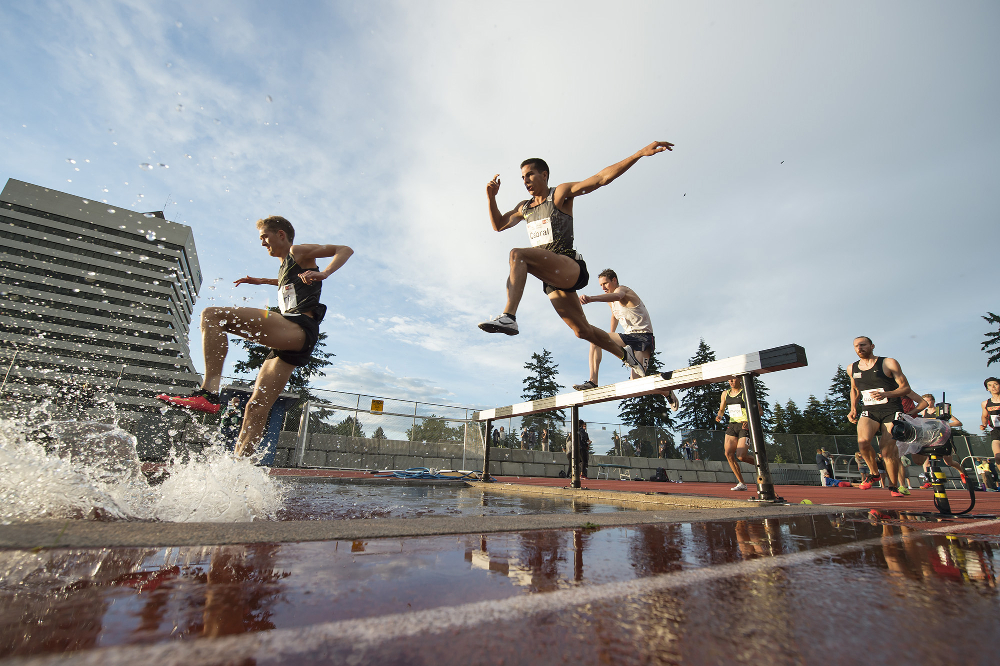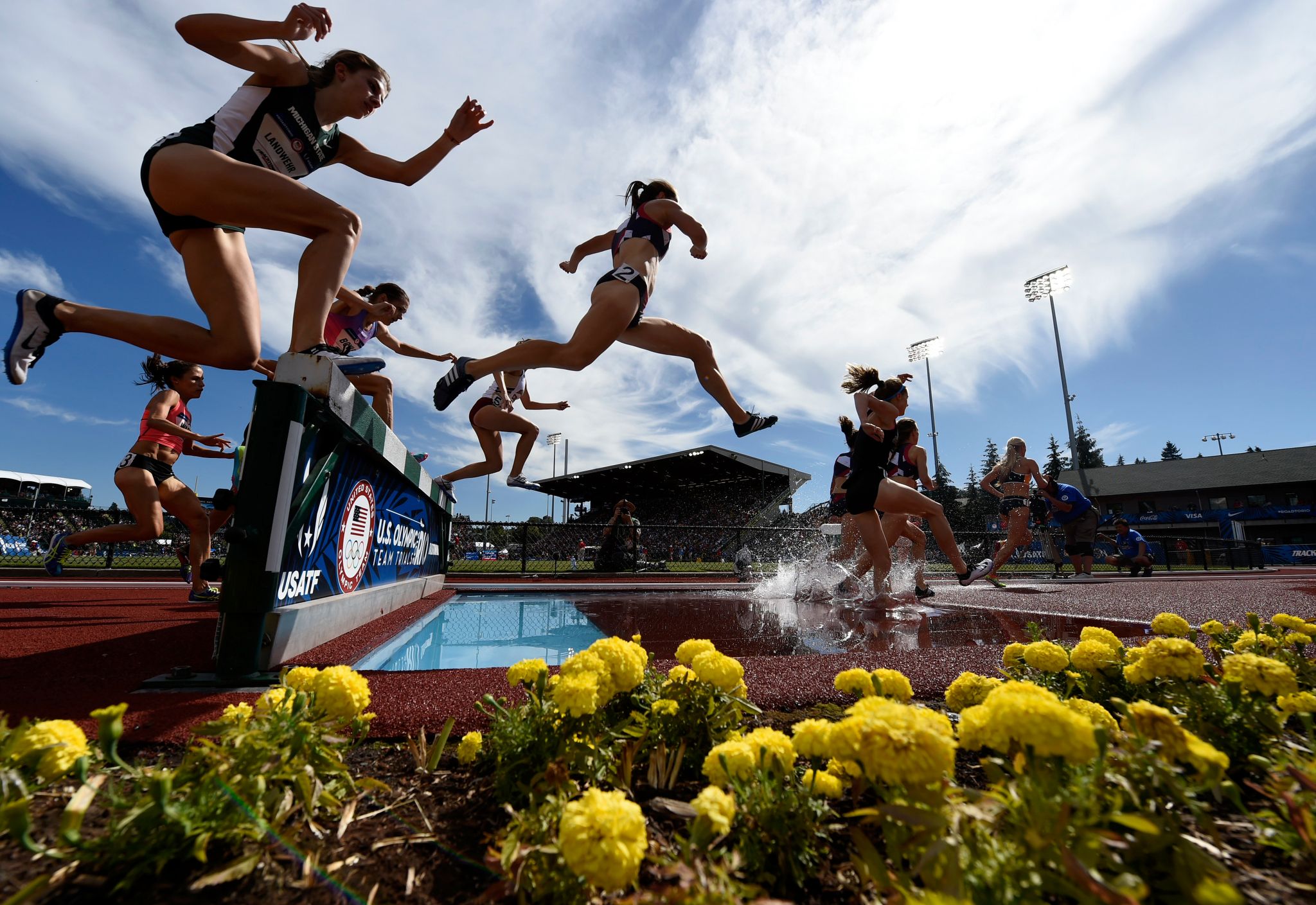Steeplechase History and Evolution: Steeplechase Olympics Fall

The steeplechase, a thrilling and demanding race, has a rich history spanning centuries, evolving from its humble beginnings to its current form as a highly competitive Olympic discipline. The unique combination of speed, endurance, and obstacle navigation makes it a captivating spectacle for both participants and spectators.
Origins and Early Development, Steeplechase olympics fall
The origins of the steeplechase can be traced back to 18th-century England, where fox hunts were a popular pastime among the aristocracy. These hunts often involved riders navigating challenging terrain, including streams, fences, and other natural obstacles. The term “steeplechase” itself is believed to have originated from a race held in 1752, where riders had to jump over a church steeple in the town of West Malling, Kent. However, this specific race was a one-time event, and the term “steeplechase” gradually became associated with any cross-country race that involved jumping over obstacles.
Evolution of the Course Design and Obstacles
Early steeplechase courses were highly variable, with the obstacles often being determined by the natural features of the terrain. As the sport evolved, standardized courses emerged, with a specific number and type of obstacles. The most common obstacle in modern steeplechase racing is the water jump, which typically involves a ditch filled with water that must be jumped over. Other common obstacles include fences, hurdles, and banks.
Rules and Regulations
The rules and regulations of steeplechase racing have evolved over time to ensure fairness and safety. In the early days, there were few formal rules, and races were often held over varying distances and with different types of obstacles. The first official steeplechase rules were established in the mid-19th century, and these rules have been continuously refined and updated to reflect the changing nature of the sport.
Modern steeplechase races are typically held over distances ranging from 2,000 to 3,000 meters, with a specific number of obstacles that must be cleared.
The rules governing the obstacles are designed to ensure that they are safe for both horses and riders, and penalties are imposed for failure to clear an obstacle correctly. The use of whips and spurs is prohibited, and riders are required to wear helmets and protective clothing.
Comparison of Historical and Modern Steeplechase Racing
- Course Design: Historical steeplechase courses were often more variable and less standardized than modern courses. Modern courses are typically designed with a specific number and type of obstacles, and the distances are standardized.
- Obstacles: Historical steeplechase obstacles were often natural features of the terrain, while modern courses feature standardized obstacles such as water jumps, fences, and hurdles.
- Rules and Regulations: Historical steeplechase races were often less regulated than modern races. Modern races have strict rules governing the obstacles, equipment, and rider conduct.
Steeplechase in the Olympics

The steeplechase, a thrilling and challenging track and field event, has been a mainstay of the Olympic Games since its debut in 1900. This unique race, characterized by its combination of speed, endurance, and technical hurdles, has captivated audiences worldwide, showcasing the remarkable athleticism of the world’s best runners.
Inclusion in the Olympic Games
The steeplechase made its first appearance in the Olympic Games at the 1900 Paris Games. Its inclusion was a testament to the growing popularity of this demanding race, which had emerged in England in the late 19th century. The event’s inclusion in the Olympics helped to further elevate its status and solidify its place among the premier track and field disciplines.
Key Athletes
Over the years, numerous legendary athletes have dominated the steeplechase events in the Olympics. These runners have consistently pushed the boundaries of human performance, setting new records and inspiring generations of athletes. Some of the most prominent figures include:
- Kenenisa Bekele (Ethiopia): Bekele, a three-time Olympic gold medalist, holds the world record in the steeplechase, having clocked an astonishing time of 7:53.63 in 2004. His dominance in the event is unparalleled, and he is widely considered one of the greatest steeplechasers of all time.
- Saif Saaeed Shaheen (Qatar): Previously known as Stephen Cherono, Shaheen won the Olympic gold medal in 2004, setting a new Olympic record. He is known for his exceptional speed and his ability to maintain a strong pace throughout the race.
- Ezekiel Kemboi (Kenya): Kemboi, a four-time Olympic medalist, is renowned for his aggressive tactics and his mastery of the water jump. He has consistently been a force to be reckoned with in the steeplechase, and his victory in the 2012 London Olympics was particularly memorable.
- Conny Sodergren (Sweden): Sodergren, a two-time Olympic medalist, was a dominant force in the steeplechase during the 1980s. He is known for his powerful stride and his ability to overcome challenging obstacles.
Strategies and Techniques
Success in the steeplechase requires a unique combination of speed, endurance, and technical proficiency. Successful steeplechase runners employ a variety of strategies and techniques to overcome the challenges of the race:
- Pacing: Steeplechase races are typically run at a fast pace, and runners must carefully manage their energy throughout the event. A well-executed pacing strategy is crucial for maintaining a strong finish.
- Hurdle Technique: The steeplechase features 28 hurdles, including the iconic water jump. Runners must develop a smooth and efficient hurdle technique to avoid losing momentum and minimize the impact on their overall pace.
- Water Jump: The water jump is the most challenging obstacle in the steeplechase. Runners must approach the jump with speed and precision, ensuring they clear the barrier and land safely in the water.
- Mental Toughness: Steeplechase races are physically and mentally demanding. Runners must possess a strong mental fortitude to handle the pressure of the competition and overcome fatigue.
The Challenges of Steeplechase Racing

The steeplechase, with its combination of endurance running and obstacle negotiation, presents a unique set of physical and mental challenges for athletes. These challenges are not only demanding but also shape the strategies and tactics employed by runners to succeed in this grueling discipline.
The Impact of Obstacles on Race Strategy and Performance
The presence of obstacles in a steeplechase significantly alters the race strategy and demands a different approach compared to a standard track race. The water jump, in particular, requires runners to adjust their stride and pace, and often results in a temporary slowdown. The barriers, though less demanding than the water jump, still necessitate careful timing and coordination to avoid stumbling or falling.
The strategic impact of obstacles extends beyond the physical challenges. Runners must carefully plan their approach to each obstacle, considering their position in the race, the proximity of other competitors, and the remaining distance. Some athletes prefer to take a more cautious approach, conserving energy by slowing down before obstacles. Others, seeking to gain an advantage, may choose to maintain their pace and risk a more aggressive obstacle negotiation.
Common Injuries Associated with Steeplechase Racing
The demanding nature of steeplechase racing makes athletes susceptible to various injuries, particularly those affecting the lower extremities.
- Ankle injuries: The repeated stress placed on the ankles during obstacle negotiation can lead to sprains, strains, and even fractures.
- Knee injuries: The impact forces associated with jumping over barriers and landing after the water jump can contribute to knee pain, ligament tears, and cartilage damage.
- Foot injuries: Stress fractures, plantar fasciitis, and Achilles tendonitis are common foot injuries associated with the repetitive impact and strain experienced in steeplechase racing.
To mitigate these risks, steeplechase athletes often incorporate specific training methods and injury prevention strategies. These include:
- Strength and conditioning: Strengthening exercises targeting the lower body, core, and upper body help improve muscle strength, balance, and coordination, reducing the risk of injuries.
- Flexibility and mobility: Regular stretching and mobility exercises enhance joint range of motion and flexibility, reducing the likelihood of muscle strains and tears.
- Proper footwear: Wearing appropriate running shoes with adequate cushioning and support can minimize the impact on the feet and ankles, reducing the risk of stress fractures and other foot injuries.
- Obstacle training: Specific drills and exercises designed to simulate the challenges of the water jump and barriers help athletes develop the necessary skills and technique to navigate obstacles safely and efficiently.
Steeplechase olympics fall – The steeplechase at the Olympics is always a nail-biter, and this year’s fall was no exception! It reminded me of Quincy Hall, quincy hall , with its rich history and legacy of impact. Just like the steeplechase, Quincy Hall is full of twists and turns, and you never know what to expect next!
The steeplechase at the Olympics is always a nail-biter, especially with the Ethiopians in the mix. They’ve dominated the event for years, and their dominance is well documented in this article. It’s a sight to behold, seeing them leap over those barriers with such grace and power.
But with so much talent out there, who knows what’ll happen in the next Olympics? It’s going to be epic, no doubt!